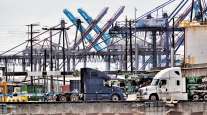Lax Chassis Rule Enforcement Reduces Safety, Truckers Say
This story appears in the Oct. 21 print edition of Transport Topics.
Four-year-old intermodal equipment safety rules that were supposed to make chassis safer have failed to accomplish that goal because the Federal Motor Carrier Safety Administration isn’t enforcing the law, according to trucking officials.
“Nothing has changed,” Curtis Whalen, executive director of the Intermodal Motor Carriers Conference of American Trucking Associations, told Transport Topics last week, charging that the agency’s own inspections have uncovered frequent defects that haven’t been punished.
“The law is not working,” he said. “We are now in a situation where I think the audits so far have shown there hasn’t been an improvement in the quality of chassis offered. There is a very high level of noncompliance.”
FMCSA declined to provide details of any of its inspections. In May, Jack Van Steenburg, the agency’s chief safety officer, told truckers at an Intermodal Association of North America meeting that as many as three inspections of equipment providers would be done this year.
FMCSA didn’t respond to requests for comment on the truckers’ assertions by press time as the government reopened Oct. 17.
When asked by TT for information about the results of inspections of intermodal equipment providers, agency spokesman Duane DeBruyne said FMCSA doesn’t release results of those inspections except through Freedom of Information Act requests.
The reason, he said, was concern about legal action that might arise from issues raised in those reviews.
TT requested that information for leasing companies, pool operators and major ocean carriers on Oct. 16. No results had been received by press time.
FMCSA created chassis safety rules in 2009, nearly four years after a law was passed that required providers of intermodal equipment, known as IEPs, to ensure that chassis were safe and “roadable,” or roadworthy.
The rules were meant to address trucker complaints that they were being fined and penalized for chassis with defects such as misaligned brakes and lights that didn’t work properly while they were in operation.
“It appears to me that since there has been no enforcement action on the part of FMCSA . . . the industry has chosen to ignore the new regulations, returning to a model that has proven to be ineffective,” said David Manning, president of TCW, a drayage operator based in Nashville, Tenn. “Rules without enforcement will not improve the quality of the chassis on the highway.”
“There was an initial improvement in the quality of the chassis shortly before the roadability rules became effective,” Manning told TT. “Sadly, that is not the case today. It is very much back to the old maintenance model today, where the equipment providers expect the motor carriers to find defects before leaving a facility and take the unit through a repair lane to have the defects repaired before hitting the highway.”
He added: “FMCSA recognized during the rulemaking process that this system does not work. According to the law, equipment providers are supposed to have a systematic maintenance program and tender roadable equipment to the motor carrier.”
Manning also said roadable chassis are not clearly discernible from ones needing repairs.
Whalen and Manning said their comments were directed at FMCSA and not at particular individual equipment providers.
Chassis currently are provided by leasing companies, ocean carriers and railroads, along with some truckers.
Leasing companies have gradually acquired a majority of chassis as some ocean carriers have moved away from the prior approach of providing that equipment to truckers at no cost.
Whalen offered one solution.
“If the equipment is not roadable, [providers] need to be shut down. FMCSA needs to send the message loud and clear that there are consequences. If they close down even one operator, they will all get the message,” he said. “Providers are still using the truckers to do unpaid quality control,” he said, forcing drivers who detect defects in chassis before they leave a terminal to take the equipment to repair lines and wait for a replacement.
Whalen also said it was common to have a chassis with a red tag that indicates a defect to have a container already mounted on it when a driver arrives for a pickup.
“We take strong issue with that,” Whalen said. “There isn’t a clearer violation of the law than that. It is in the law that providers have to provide roadable equipment.”
Whalen noted that the transition to leasing companies as equipment providers should have created an incentive to provide better equipment because there are rental charges.
“We have to get a handle on this,” Whalen said. “We are paying for the equipment, and we are not getting roadable chassis.”
One particular area of concern, Whalen said, was South Atlantic locations, where hot weather raises road temperatures, causing stress on tires and other equipment.




